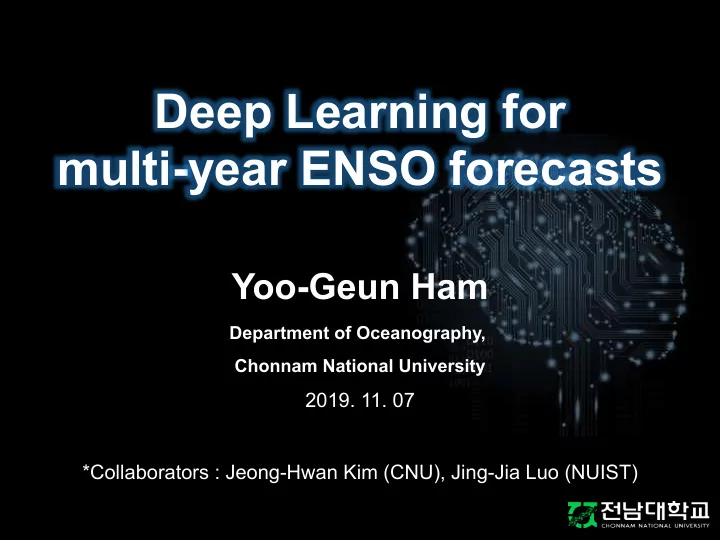

Deep Learning for multi-year ENSO forecasts Yoo-Geun Ham Department of Oceanography, Chonnam National University 2019. 11. 07 *Collaborators : Jeong-Hwan Kim (CNU), Jing-Jia Luo (NUIST)
What is El Nino? Area for NIno3.4 index El Nino is defined when Sea Surface Temperature (SST) over the equatorial Eastern • Pacific is higher than the normal year. Definition of El Nino index (Nino3.4 index) : Equatorial Eastern Pacific area-averaged • SST. 3
El Nino’s global impact Heavy rainfall Heatwave Drought Wildfire 4
Deep Learning Algorithm Convolutional Neural Network Deep Neural Network (CNN) (Deep Learning) Use for the detection of the object in the image Recurrent Neural Network (RNN) Autonomous Car (self-driving car) Flower Search Convolutional Neural Network (CNN)
Basin concept of statistical forecast of the El Nino event 6-months before Peak phase 1-year before the El Nino occurs Time Increased temperature over the equatorial western Pacific propagates to east to induce El Nino.
Application of the CNN to climate forecasts Input layer Output layer Conventional Dog usage of CNN Input layer Output layer Application to ENSO Amplitude of Nino3.4 index forecast
Structure of CNN for ENSO Prediction
Difficulties of applying CNN to climate forecasts Enough numbers of samples to train the CNN model is crucial (e.g., number • of samples of image for MNIST set is 100,000) The oceanic temperature is observed after late 19 th (less than 150 years). • It is very challenging to train the CNN model only with the observations due • to the lack of samples. Model simulations from Coupled Model Intercomparison Project is utilized to train the CNN. 9
CMIP5 simulations El Nino precipitation Global Temperature in time in CMIP5 models
Transfer learning Large number Small number of samples of samples of Pear of Apples Model Model identifying identifying Pear Apple 1 st training : CMIP5 archives (number of samples : about 2,700) • 2 nd training : Reanalysis from 1871 to 1973 • Initial weighting for 2 nd training is final weighting of 1 st training • 11
All-season correlation Skill of 3-months-averaged Nino3.4 CNN *Validation period : 1984-2017 12
Sensitivity Exp. : Number of samples & Transfer learning Required number of samples : at least 1,000. • Transfer learning has advantages on ENSO forecast. • 13
Heat map for the 18-month forecast of 97/98 El Nino event CNN model Conv. dim. y-dim. x-dim. Heatmap Conv. dim. WHWP Southwest cooling IO cooling (Park et al., à nIOD 2017) (Izumo et al. 2010) Off-equatorial WP positive HC (Jin, 1997; Anderson, 2007) 14
Eastern Pacific (EP) vs Central Pacific (CP) El Nino CP El Nino EP El Nino DJF Precipitation anomalies DJF Precipitation anomalies The global impact between EP and CP El Ninos are dramatically different. It is crucial to predict the El Nino type as well as the occurrence of the El Nino. 15
Skill of El Nino-type (CP, EP, mixed) forecasts
Visit our website http://ocl.jnu.ac.kr
Summary and Conclusion A statistical forecast model employing a deep learning approach produces • skillful ENSO forecast for lead times of up to one and a half years. To circumvent the limited amount of observation data, we use transfer • learning to train a Convolutional Neural Network (CNN) first on the Coupled Model Intercomparison Project phase 5 (CMIP5) historical simulations and subsequently on reanalysis from 1871 to 1973. During the validation period from 1984 to 2017, the all-season correlation • skill of the Nino3.4 index of the CNN model is significantly higher than those of current state-of-the-art dynamical forecast systems. Also, the CNN model is better at predicting the detailed zonal distribution • of sea surface temperatures, overcoming a weakness of dynamical forecast models. A heatmap analysis indicates that the CNN model predicts ENSO events • based on physically reasonable precursors. The CNN model can be a powerful tool for both the prediction of ENSO • events and the analysis of their associated complex mechanisms.
Thank you for your attention E-mail) ygham@jnu.ac.kr Office number) 062-530-3461 Homepage) http://ocl.jnu.ac.kr/
CMIP5 model output Eq. SST during the El Nino (Kug et al. 2012) ENSO-related feedback amplitude (Kim et al., 2013) The CMIP5 models have abilities to simulate realistic ENSO to some extent.
Heat map analysis Class activation map을 이용하여 CNN 모형이 각 카테고리를 어떻게 판단했는지, • 입력의 어떤 부분이 이를 판단하게 만들었는지 찾을 수 있음 Global average pooling을 통해 파라미터의 수를 획기적으로 감소시킬 수 있음 • (CNN에서 fully connected layer가 가장 많은 파라미터를 차지함) 22
El Nino forecast results for the period of 1984-2017 *EXP1 : Use 2nd Ensemble of the model integration if possible *EXP2 : Ensemble member is randomly selected *EXP3 : Model realization is randomly selected among all integrations *EXP4 : Model realization is randomly selected for each year 23
18-months lead forecast for DJF Nino3.4 index 3
Forecast skill of Feed-forward Neural Network (FFNN) model Correlation skill of DJF Nino3.4 index for 18-months lead *Correlation skill of the CNN model : 0.64 The FFNN model with any combination of EOF PCs cannot beat the CNN model 25
Forecast skill of Feed-forward Neural Network (FFNN) model 26
SST anomalies from MJJ 1996 from FMA 1997 WHWP Negative cooling IOD NTA Negative cooling IOBW • Negative IOD --> (14-months) El Nino (Izumo et al., 2010) • Negative IO Basin-wide Warming (IOBW) --> (12-months) El Nino (Kang and Kug, 2006) • WHWP cooling --> (17-months) El Nino (Park et al., 2018) 27
CP- & EP-El Nino precursor patterns Through the heatmap analysis, the precursors for CP-El Nino over Indian Ocean and Southern Pacific is revealed.
Lag regression for IO and SP precursor for CP-El Nino Regressed SST anomalies after 1-year IO SP
Visit our website http://ocl.jnu.ac.kr
Recommend
More recommend